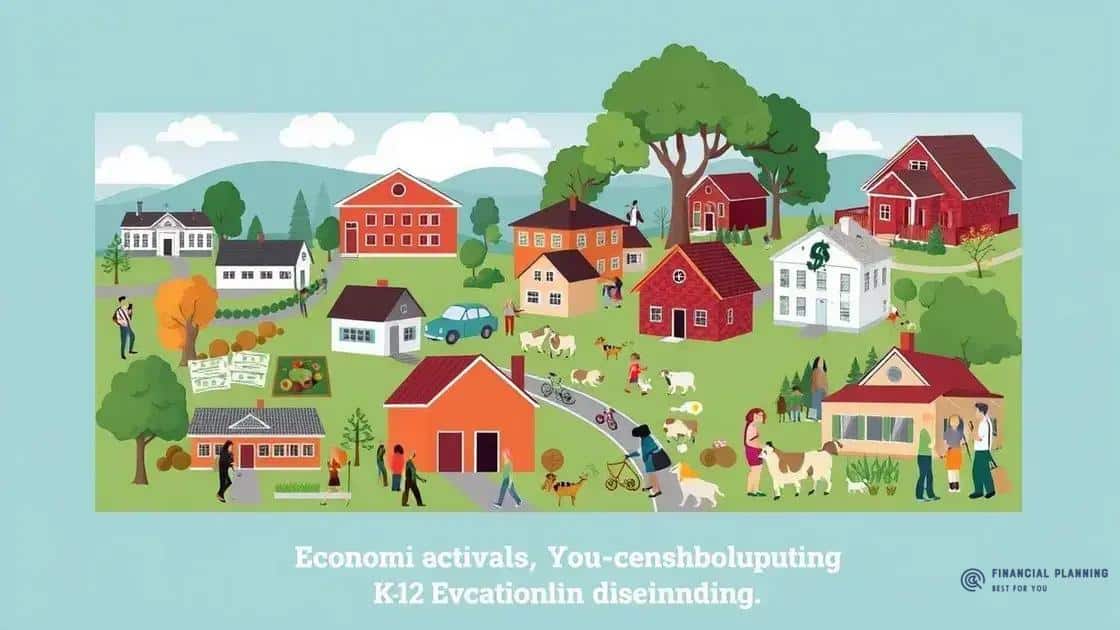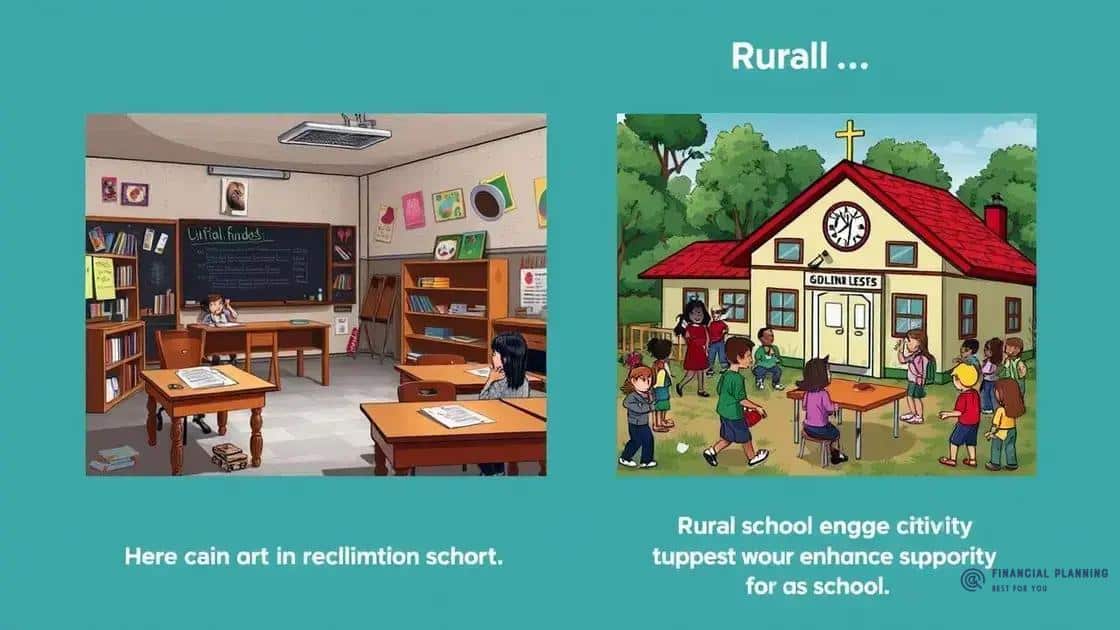Disparities in education funding for K-12 schools

Disparities in education funding for K-12 schools arise from unequal resource distribution based on socioeconomic factors, leading to varying academic outcomes and reduced opportunities for students in underfunded districts.
Disparities in education funding for K-12 schools continue to shape the educational experience for countless students. Have you ever wondered how these differences in funding affect schools in your area? Let’s dive into this critical topic and explore the underlying causes and consequences.
Understanding the funding landscape
Understanding the funding landscape for K-12 schools is essential to grasp the full picture of education disparities. Schools across different regions receive varying levels of financial support, which significantly impacts their resources and overall student success.
The funding methods used can differ widely. Many schools rely heavily on state and local funds, which can create stark differences between districts.
For instance, wealthier areas often have access to more substantial funding than those in low-income regions. This disparity can lead to a cycle of inequality that affects students for years.
Key Sources of Funding
Three primary sources contribute to K-12 school funding:
- Local Property Taxes: A significant portion comes from local taxes, meaning schools in wealthier neighborhoods can collect more funds.
- State Education Budgets: State funds also play a role and can vary based on policies and revenue.
- Federal Funding: Although a smaller percentage, federal contributions are important, particularly for low-income schools.
Understanding how these funds are distributed helps reveal the inequalities that exist. Schools in affluent districts may afford advanced technology and extracurricular programs, while others struggle to provide basic supplies.
Variability and Challenges
The variability in funding creates challenges at many levels. Schools facing budget cuts must make tough decisions about which programs to maintain. These choices affect class sizes, faculty hiring, and even the availability of after-school activities.
Community engagement can help bridge some of these gaps, as parents and local leaders advocate for fair funding. Consistent dialogue around school funding is necessary to drive positive change.
If we want to close the gap in education funding, understanding these foundational elements is crucial. Without a deep grasp of the funding landscape, efforts to reform and improve educational equity may fall short.
Key factors behind funding disparities

Several key factors contribute to the funding disparities in K-12 education. Understanding these elements is crucial for tackling this pressing issue. Some factors are rooted in policy while others stem from economic circumstances.
Socioeconomic Status
One of the most significant factors is the socioeconomic status of a community. Wealthier neighborhoods often provide more resources through local property taxes. This results in better facilities and more educational programs, which can enhance student outcomes.
- Local Funding: Schools in affluent areas collect more from local taxes, leading to better funding.
- Poverty Rates: Higher poverty rates in certain districts mean less funding available.
- Community Investment: Communities with more financial resources can allocate more for education.
This cycle creates a situation where students in low-income areas may struggle to achieve similar successes as their wealthier peers.
State and Federal Policies
State and federal policies also play a critical role in funding. Different states allocate funds based on varied criteria, which can lead to unequal distributions. For some districts, relying heavily on state funding can be risky, especially if budgets are tight.
Additionally, many policies are influenced by historical inequities, further perpetuating the problem. The lack of consistent funding formulas means that some schools may not receive adequate support despite their needs.
Understanding these factors highlights the complex landscape of educational funding. By recognizing how socioeconomic trends and policy decisions intersect, communities can work strategically to address these disparities.
Impact on student outcomes and performance
The impact of funding disparities on student outcomes and performance is significant. When schools lack adequate resources, students often face challenges that can hinder their academic achievements.
For instance, students in underfunded schools may not have access to essential materials such as textbooks and technology. Without these tools, learning becomes difficult, and engagement levels drop. This situation can lead to lower test scores and graduation rates.
Academic Performance Indicators
Research shows that funding levels correlate with key academic performance indicators:
- Standardized Test Scores: Schools with more resources typically see higher scores.
- Graduation Rates: Adequate funding supports programs that help students stay in school.
- College Enrollment: Students from better-funded schools are more likely to attend college.
Moreover, disparities in funding not only affect academics but also emotional and social development. Schools with lower budgets often struggle to provide counseling services and extracurricular activities. These programs are essential for building a well-rounded educational experience.
The Role of Class Sizes
Another factor influenced by funding is class size. Smaller class sizes allow teachers to give more individual attention to students.
This direct support can lead to better understanding and retention of the material. Conversely, crowded classrooms often result in less personal interaction and engagement, further impacting student learning.
Furthermore, teachers in underfunded schools may be overworked and underpaid, leading to burnout and high turnover rates. This instability affects student relationships and learning continuity.
By addressing funding disparities, we can create environments where all students have the opportunity to succeed. Ensuring adequate and equitable funding is vital for fostering positive educational outcomes.
Case studies of affected districts

Examining case studies of affected districts reveals the real-world consequences of funding disparities in K-12 education. Different school districts experience unique challenges based on their specific funding situations.
Case Study 1: Urban District Challenges
In urban areas with high poverty rates, schools often face severe budget constraints. One example is a district where schools receive significantly lower funding than those in affluent neighborhoods. As a result, they struggle to provide basic supplies and extracurricular activities.
- Resource Limitations: Many classrooms lack essential materials, leading to an uneven educational experience.
- High Teacher Turnover: Teachers may leave for better-paying positions in wealthier districts, causing instability.
- Low Test Scores: Academic performance falls short compared to better-funded districts, impacting student futures.
These factors create a cycle of disadvantage, making it difficult for students to succeed.
Case Study 2: Rural District Solutions
In contrast, some rural districts face different types of challenges. One rural district implemented community-based funding solutions to supplement their state allocations. By engaging local businesses and families, they sought to improve their financial situation.
This approach resulted in:
- Increased Resources: More funding allowed for better technology integration.
- Community Engagement: Local support fostered pride and investment in schools.
- Innovative Programs: New after-school programs and tutoring were introduced, boosting student engagement.
Despite these achievements, rural areas still struggle with geographical isolation and fewer opportunities for advanced courses.
By studying these districts, we can learn valuable lessons on addressing funding disparities. Each case highlights the need for tailored solutions to support diverse communities.
Possible solutions to address funding issues
Finding solutions to address funding issues in K-12 education is crucial for promoting equity among students. Various strategies can help level the playing field for schools that are underfunded.
Increased State Funding
One effective approach is advocating for increased state funding. When states allocate more resources to education, they can help districts that are struggling financially. This funding can be distributed more fairly by:
- Adjusting Funding Formulas: States can revise their funding formulas to ensure that low-income districts receive adequate support.
- Targeting High-Need Schools: Directing funds specifically to schools with the greatest needs can significantly improve educational outcomes.
- Investing in Teacher Salaries: Ensuring competitive salaries helps retain qualified teachers in underfunded areas.
By making these changes, states can create more equitable funding systems.
Community Engagement
Another important strategy is fostering community engagement. When parents, local businesses, and organizations come together, they can form partnerships that help fund schools. Some effective ways to engage the community include:
- Fundraising Events: Organizing events, such as fairs or runs, can raise essential funds for school programs.
- Corporate Sponsorships: Local businesses can sponsor specific initiatives within schools, providing both financial support and real-world resources.
- Boosting Volunteer Efforts: Engaging community members to volunteer in schools can enrich student experiences without significant financial costs.
Such partnerships can lead to more significant investments in education and increased enthusiasm for school activities.
Additionally, implementing grants and funding opportunities can also provide necessary resources. Schools can apply for state or federal grants designed to enhance learning environments, technology supports, and special programs.
Through collaborative efforts and targeted investments, communities can effectively address funding disparities and improve educational opportunities for all students.
disparities in education funding for K-12 schools is essential for ensuring all students have access to quality education.
By understanding the underlying factors and implementing effective solutions, communities can work towards more equitable educational opportunities.
Increased state funding, community engagement, and innovative funding options can greatly enhance the educational experience for students in underserved areas.
Collaboration among stakeholders is key to driving meaningful change and achieving better outcomes for every child.
FAQ – Frequently Asked Questions about Education Funding Disparities
What are funding disparities in K-12 education?
Funding disparities refer to the unequal distribution of financial resources among schools, often based on local property taxes and socioeconomic factors.
How do funding disparities affect student performance?
These disparities can lead to differences in academic outcomes, resources, and opportunities for students, impacting their overall educational experience.
What solutions exist to address education funding issues?
Possible solutions include increasing state funding, fostering community partnerships, applying for grants, and targeting resources to high-need schools.
How can communities support underfunded schools?
Communities can engage through fundraising events, local business sponsorships, and volunteering efforts to enhance resources and support for schools.





